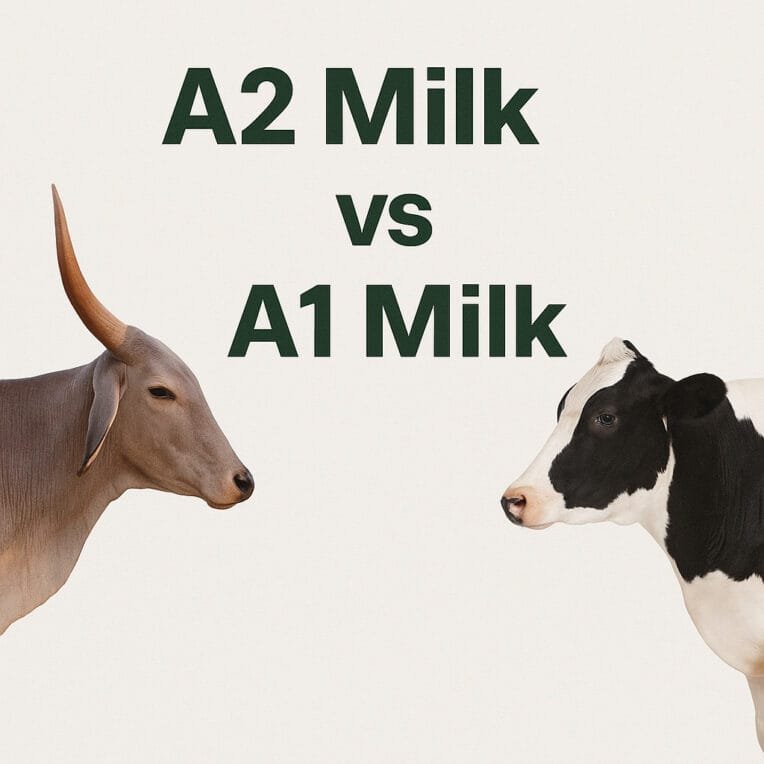If you’ve ever stood in the dairy aisle feeling a little puzzled about whether to pick A1 milk or A2 milk, you are not alone. Lately, everyone seems to be talking about A2 milk as the gentler, more traditional choice, while A1 milk is the everyday option most of us grew up with. But what’s the real difference? And more importantly, does it matter for your family’s health and comfort? Let’s break it down together in the most homely, kitchen-table way possible.
Milk, after all, is not just another ingredient. It’s the thing that goes into your morning chai, that comforting glass your kids ask for before bedtime, and the secret touch in your creamy payasam or halwa. So choosing the right kind of milk feels important, doesn’t it?
What Exactly Are A1 and A2 Milk?
The main difference between A1 and A2 milk comes down to the type of protein inside. Milk is rich in proteins, and one of the key ones is beta-casein. Now here’s the science bit made simple:
- A2 milk, usually from Indian cow breeds like Gir or Sahiwal, contains only A2 beta-casein.
- A1 milk, mostly from European breeds like Holstein or Jersey, contains A1 beta-casein.
It may sound like just one tiny variation, but our bodies notice it. And that’s where the whole debate starts.
How the Body Digests These Proteins
When we drink A1 milk, the digestion process can release something called BCM-7 (beta-casomorphin-7). This compound is thought to slow things down in the gut and, for some people, may lead to bloating, gas, or that heavy, sluggish feeling.
On the other hand, A2 milk does not release BCM-7, which makes it easier for many people to digest. This is why A2 milk is often described as more soothing and comforting to the stomach. If you’ve ever noticed your child complain of tummy pain after drinking milk, or you yourself feel uncomfortable after a big glass, it might not be the lactose — it could be the type of protein.
The Health Claims
Here’s where it gets interesting.
- A2 milk is often called “anti-inflammatory milk” because it’s believed to be gentler, easier to digest, and less likely to trigger discomfort.
- A1 milk is sometimes labelled “inflammatory milk” because BCM-7 may cause issues for sensitive individuals.
Now, I should tell you: global food authorities say that while early studies are promising, more research is needed before we can make absolute claims. But if you’ve ever quietly avoided milk because it just doesn’t sit right, A2 could be worth trying.
Nutrition Face-Off
From a nutrition standpoint, both A1 and A2 milk are almost identical. They have the same amount of protein, calcium, vitamins, and minerals. Both give you that boost of B12, riboflavin, and potassium. They both make your tea richer and your kheer creamier. The real difference is not about nutrients, but about how your body feels after drinking them.
A2 Milk in India and Around the World
In India, native cow breeds naturally give A2 milk. Our grandparents didn’t even need to think twice about it. But with the rise of crossbred and imported cattle, A1 milk became common in many households. Now, with the renewed interest in traditional foods, more families are going back to A2.
Elsewhere, in countries like Australia, New Zealand, and the US, A2 milk is sold as a premium product, often at higher prices, and many people swear by it for reducing digestive troubles.
Should You Switch?
This really depends on your family’s needs.
- If regular milk gives you no issues, you may not need to change.
- If someone in your family complains of bloating or stomach discomfort after milk, but lactose intolerance has been ruled out, A2 is worth a try.
- If you are lactose intolerant, though, switching won’t solve it. In that case, lactose-free milk or plant-based options like almond, soy, or oat milk will help more.
And if you just want to honour tradition and support Indian native cows, A2 milk is a beautiful way to do that while keeping the connection to what your grandmother once poured into your glass.
The Bottom Line
A2 and A1 milk are both nutritious and healthy in their own ways. But for many families, the small difference in protein makes all the difference in comfort. If you’ve been struggling with digestion after milk, A2 could be the gentle, homely solution you’ve been looking for.
At the end of the day, it’s about listening to your body and your family. If a glass of A2 milk leaves you feeling lighter, more energetic, and ready for your day, then that choice is as nourishing for your heart as it is for your health.
Milk, after all, isn’t just about calcium and proteins. It’s about the warmth of a cup of chai with your mother, the creamy kheer at festivals, and the comfort of pouring something wholesome for your children. So whether you stick with A1 or move to A2, let it be about more than science — let it be about comfort, tradition, and joy.






